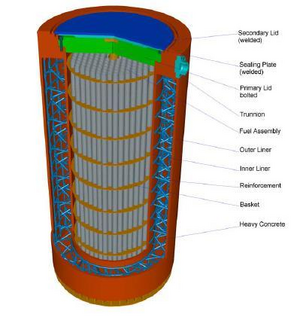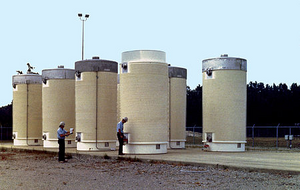Half-thicknesses of various substances
Dependence of half-thickness[edit | edit source]
The size of the half-thickness of the fabrics depends on both the nature of the shading material and the nature of the radiation.
Wave-corpuscular dualism manifests itself in radiation : macroscopic bodies interact with the environment as a uniform whole. Radiation with longer wavelengths behaves similarly , so we can observe, for example, the reflection of light , when we look at visible light as a ray. The situation is different for radiation with shorter wavelengths, when the corpuscular character is manifested. The interaction of matter and radiation takes place at an elementary level, thanks to which a situation can arise when a quantum of radiation simply passes through matter. This probability is increased by the low density of the given substance. The second possibility is the interaction of the radiation with the substance due to the loss of radiation energy, hence the gradual retardation.
If we consider a uniform beam of radiation, its intensity depends exponentially on the thickness of the substance it passes through and the linear attenuation coefficient, which is higher the greater the density and atomic weight of the substance, and lower at higher radiation energy. Similar to the linear attenuation coefficient is the effective cross section, which is based on the idea of atoms as spherical bodies of a certain radius that either absorb or pass radiation. The larger the effective surface area of this body, the greater the probability of absorption. The unit of effective cross-section is 1 barn =10-28 m2
Semi-thicknesses of selected substances and their use[edit | edit source]
Lead[edit | edit source]
Lead is an element with a high specific density (11 340 kg.m-3) and a proton number (82). [1]
It, therefore, has a high electron density and is a good shielding material for γ radiation.
On the contrary, it is not itself a suitable material for shielding β radiation , as intense bremsstrahlung radiation is produced and a very thick layer of lead would have to be used to shield this bremsstrahlung radiation. Therefore, it is used in combination with another light material (plexiglass, aluminum) to shield β- radiation , where its thin layer serves to shield bremsstrahlung radiation. A thicker layer must be used for β+ radiation because the resulting bremsstrahlung has a higher energy than β-. Lead plates are used in medicine as protection against ionizing radiation.
Furthermore, for example, lead containers are used for transporting and storing radiators. And if it is necessary to maintain optical visibility, so-called leaded glass can be used.
Air[edit | edit source]
Air has a very low proton density.
Half-thicknesses for alpha radiation of different intensities are in the order of tens of centimeters, for beta in the order of meters.[2] The half-thickness for gamma radiation with an intensity of 1 MeV is around 90 m.
Water[edit | edit source]
Water has a higher proton density than air, so the half-thickness for gamma radiation is only about 10 cm.
In nuclear energy, it is used in the storage of nuclear waste in the so-called wet storage method. A layer of water with a thickness of at least 2.5 m performs both a cooling and shading function in this storage method. The disadvantage of this method is the creation of liquid radioactive waste.[3]
Concrete[edit | edit source]
Despite its low density, concrete has very good shielding properties. For example, for radiation with an energy of 1.5 MeV, lead with a half-thickness of 1.174 cm is needed. For the same radiation, concrete with a half-thickness of 5.72 cm is needed. It is therefore used in gamma radiation shielding. Unlike lead and iron, it also shields neutron radiation well. Concrete is used, for example, in the so-called dry method of storing radioactive material in power plants, as part of the so-called CASTOR and CONSTOR containers, together with steel and other materials.
Steel[edit | edit source]
Due to its density, which is usually between 7,750 and 8,050 kg.m-3, steel is used, like lead, to shield γ radiation. Together with concrete, it is used for the production of CASTOR and CONSTOR containers.
Aluminum[edit | edit source]
Aluminum has a much lower density and proton number than lead. Therefore, it is also used for beta shielding as it reduces bremsstrahlung.
Table of semi-thicknesses of selected materials [4][edit | edit source]
The semi-thickness values of the selected materials are given in centimeters. For values marked a the half-thickness value will no longer increase when the intensity is increased.
| Energy | Lead (11.35 g/cm3) | Iron (7.86 g/cm3) | Aluminum (2.82 g/cm3) | Water (1 g/cm3) | Air (0,0012929 g/cm3) | Concrete (2,35 g/cm3) |
|---|---|---|---|---|---|---|
| 0,3 MeV | 0,16 | 0,845 | 2,457 | 5,823 | 5,133. 103 | 2,76 |
| 0,5 MeV | 0,396 | 1,062 | 2,936 | 7,532 | 6,243. 103 | 3,39 |
| 1 MeV | 0,816 | 1,471 | 4,225 | 9,76 | 8,451. 103 | 4,65 |
| 1,5 MeV | 1,174 | 1,833 | 5,058 | 12,157 | 10,434. 103 | 5,72 |
| 2 MeV | 1,358 | 2,074 | 6,187 | 13,86 | 12,375. 103 | 6,66 |
| 2,5 MeV | 1,443 | 2,294 | 6,794 | 15,75 | 13,860. 103 | |
| 3 MeV | 1,474 | 2,343 | 7,372 | 17,769 | 15,065. 103 | 8,15 |
| 3,5 MeV | 1,506a | 2,585 | 7,965 | 19,25 | 16,500. 103 | |
| 4 MeV | 2,76 | 8,349 | 20,382 | 17,769. 103 | 9,36 | |
| 5 MeV | 2,851 | 9,625 | 23,1 | 20,382. 103 | 10,34 | |
| 10 MeV | 2,948a | 11,745 | 30,13 | 24,750. 103 | 13,86 | |
| 20 MeV | 12,157a | 38,5 | 33,000. 103 | 14,14a | ||
| 30 MeV | 40,764 | 33,640. 103 | ||||
| 40 MeV | 43,312 | 34,650. 103 |
Links[edit | edit source]
Reference[edit | edit source]
- ↑ MIKULČÁK, Jiří. Matematické, fyzikální a chemické tabulky pro střední školy. 3. edition. Prometheus, 2006. ISBN 80-85849-84-4.
- ↑ KLIK, František – DALIBA, Jaroslav. Jaderná energetika. 1. edition. Vydavatelství ČVUT, 1998. pp. 145. ISBN 80-01-01280-8.
- ↑ ŠULC, Jaroslav. Ekologie jaderného palivového cyklu. 1. edition. Technická univerzita, 2011. pp. 50. ISBN 978-80-7372-776-5.
- ↑ UNIVERSITY OF FLORIDA, Division of Environmental Health and Safety Radiation Control and Radiological Services Department. Radiation Safety Short Course, Chapter 3 Radiation Protection [online]. ©2005. [cit. 2013-12-04]. <http://webfiles.ehs.ufl.edu/rssc_stdy_chp_3.pdf>.
References[edit | edit source]
- ULLMANN, Vojtěch. Astro Nukl Fyzika [online]. [cit. 2013-11-30]. <http://astronuklfyzika.cz/JadRadFyzika6.htm#Absorbce>.



